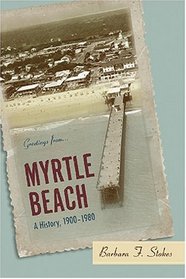Search -
Myrtle Beach: A History, 1900--1980
Myrtle Beach A History 1900--1980
Author:
A relatively young city, Myrtle Beach has quickly earned an international reputation as a tourism mecca on the South Carolina coast, yet no comprehensive history of the community's quick rise to prominence existed until now. Public historian Barbara F. Stokes fills in the blanks as she maps the development of the Grand Strand's centerpiece in th... more »
Author:
A relatively young city, Myrtle Beach has quickly earned an international reputation as a tourism mecca on the South Carolina coast, yet no comprehensive history of the community's quick rise to prominence existed until now. Public historian Barbara F. Stokes fills in the blanks as she maps the development of the Grand Strand's centerpiece in th... more »
ISBN-13: 9781570036972
ISBN-10: 1570036977
Publication Date: 12/7/2007
Pages: 258
Rating: ?
ISBN-10: 1570036977
Publication Date: 12/7/2007
Pages: 258
Rating: ?
0 stars, based on 0 rating
Publisher: University of South Carolina Press
Book Type: Hardcover
Other Versions: Paperback
Members Wishing: 1
Reviews: Amazon | Write a Review
Book Type: Hardcover
Other Versions: Paperback
Members Wishing: 1
Reviews: Amazon | Write a Review
Genres:
- Business & Money >> Industries >> Hospitality, Travel & Tourism
- Business & Money >> Industries >> Service
- History >> Americas >> General
- Travel >> Reference >> Guidebooks
- Travel >> Reference >> Beaches
- Travel >> Travel Writing
- Travel >> United States >> Regions >> South >> South Atlantic
- Travel >> United States >> States >> South Carolina >> General
- Travel >> United States >> States >> South Carolina >> Myrtle Beach




